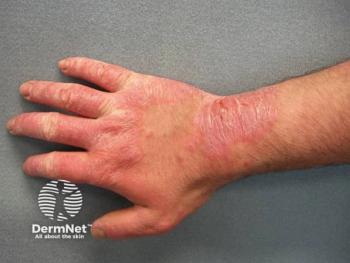
- Dermatology Times, July 2025 (Vol. 46. No. 07)
- Volume 46
- Issue 07
Systemic Therapy for Pediatric Atopic Dermatitis: A Growing Case for Early Intervention
Key Takeaways
- Dupilumab is the only FDA-approved systemic treatment for children aged 6 months to 11 years with moderate to severe atopic dermatitis.
- Untreated pediatric AD impacts sleep, growth, learning, and quality of life, with systemic consequences including increased psychiatric disorder risk.
Christopher Bunick, MD, PhD, highlights how dupilumab transforms atopic dermatitis treatment in children, improving health outcomes and quality of life beyond skin symptoms.
For decades, the treatment of moderate to severe atopic dermatitis (AD) in children has been dominated by topical therapies and short bursts of systemic corticosteroids, often prescribed reluctantly due to the well-known adverse effects of steroids. The burden of uncontrolled pediatric AD, however, extends far beyond the skin. Dermatologists now recognize AD as a systemic inflammatory disease with implications that span physical growth, mental health, immune development, and future allergic disease risk. In children aged 6 months to 11 years, this burden is especially consequential. Untreated AD impacts sleep, growth, learning, and quality of life during critical developmental years.
Dupilumab (Dupixent; Sanofi and Regeneron), the first and only FDA-approved systemic treatment for children as young as 6 months with moderate to severe AD, represents a transformative advance in care. Although other systemic agents such as cyclosporine, methotrexate, and corticosteroids have long been used off-label, they carry risks that make them unsuitable for chronic use in this age group, as well as adults.1 Clinical trials on young children are underway for additional agents, including JAK inhibitors such as upadacitinib (Rinvoq; AbbVie; approved in individuals 12 years and older), and biologics including lebrikizumab (Ebglyss; Eli Lilly and Company) and tralokinumab (Adbry; LEO Pharma), but dupilumab currently stands alone as the only approved long-term systemic option in young children (aged 6 months to 11 years).
This distinction is important, not because dupilumab’s benefits are unique, but because right now, it is uniquely accessible and critical for improving the health of children with AD.
The Hidden Burden of Pediatric AD
The visible symptoms of AD (erythema, scaling, excoriations, and lichenification) are just the surface. Children with poorly controlled AD experience chronic pruritus, fragmented sleep, school absenteeism, emotional dysregulation, and social withdrawal. Many have persistent inflammation, leading to systemic consequences. Recent data demonstrate that inadequately treated AD is associated with an increased risk of developing psychiatric disorders, attention deficit hyperactivity disorder, sleep disturbances, infections, and other inflammatory conditions.2
Moreover, untreated or poorly controlled AD increases the likelihood of progressing along the so-called atopic march, with children developing food allergies, allergic rhinitis, and asthma. In a recent population-based study, children treated with dupilumab had significantly lower risks of new-onset asthma (HR, 0.60; 0.45-0.81) and allergic rhinitis (HR, 0.69; 0.54-0.88) than those treated with conventional immunosuppressants.3 These effects were most pronounced in younger children, suggesting that early intervention may offer a window of disease modification.3 The dupilumab data show the potential for overall atopy mitigation, and that should strongly mobilize pediatricians and dermatologists to utilize dupilumab early and often in children with AD.
Growth and Bone Health
In pediatric dermatology, growth often takes a back seat to disease control. Emerging evidence suggests that the inflammation, sleep loss, and repeated corticosteroid use associated with AD can impair linear growth and bone mineralization.4,5 A recent 52-week analysis of children aged 6 years to 11 years with severe AD showed that dupilumab treatment was not associated with any impairment in height velocity. In fact, bone alkaline phosphatase, a marker of bone formation, increased significantly. These data suggest that dupilumab may allow natural growth processes to normalize, including growth stature, vertical height, and bone mineralization.5,6
By contrast, systemic corticosteroids, which remain in use for acute flares and even as maintenance therapy in some settings, are known to suppress growth and negatively affect bone density. For clinicians weighing the long-term risks and benefits of systemic treatment, this is a pivotal consideration.
Remission Beyond the Injection
One of the most compelling recent findings comes from results of open-label extension studies showing that some children treated with dupilumab achieve therapy-free remission after withdrawal. In other words, early intervention with systemic treatment may reset or reprogram the immune system enough to maintain disease control without continuous dosing. This is a tantalizing prospect in pediatric care.7
These findings, however, must be interpreted with caution. The natural history of AD includes periods of spontaneous improvement, and it remains uncertain whether remission in these cases is directly attributable to dupilumab or reflects waning disease activity over time. The absence of a control group in long-term extension studies makes it difficult to fully disentangle treatment effects from the underlying disease trajectory. Additional controlled studies are needed to confirm the durability and causal basis of therapy-free remission.
Access and Approval Lag Behind Science
Despite compelling data, systemic therapies for AD remain underused in children. Many clinicians hesitate to initiate systemic treatment in young patients, waiting for extreme disease progression before acting. This is understandable, but this practice is no longer the standard of care and needs to change for the health of the children. There is a historical reluctance rooted in safety concerns, lack of long-term pediatric data for most agents, and insurance barriers that must be overcome.
Although biologics such as tralokinumab and lebrikizumab are in clinical trials for younger age groups, and JAK inhibitors such as upadacitinib have shown impressive and rapid efficacy in adolescents, none of these agents are yet approved for children younger than 12 years. Notably, upadacitinib (oral liquid) is already approved by the FDA for use in children as young as 2 years for juvenile idiopathic arthritis, demonstrating that it has an established pediatric safety profile in other immune-mediated diseases. Its use in pediatric AD, however, remains investigational pending clinical trial completion and regulatory review.
This regulatory lag leaves dupilumab as the only viable systemic option for long-term AD control in children aged 6 months to 11 years, and pediatric and dermatology clinicians are empowered with convincing data that early intervention with dupilumab changes the health trajectory of children with AD.
Connecting Anti-Inflammatory Evidence
The clinical benefits observed in pediatric trials, such as symptom relief, improved quality of life, skin barrier restoration, and growth normalization, are not exclusive to dupilumab. These outcomes reflect the potential of effective systemic control of AD for individuals of all ages. When considering the big-picture view of the multiorgan consequences of systemic inflammation from untreated moderate to severe AD, dupilumab’s outcomes in children correlate with and explain why the anti-inflammatory properties of oral JAK inhibitors such as upadacitinib can be cardioprotective in adults.8 Although the comorbidities and consequences of systemic inflammation of AD vary from childhood to adulthood, the educational and clinical pearl is clear: Intervening early and often with systemic AD therapies can have far-ranging health benefits beyond just the skin for pediatric and adult patients.
As we await more systemic AD therapies to complete pediatric trials, in clinical practice today, only dupilumab offers a validated and approved path to the desired health outcomes in our youngest patients. The availability of an approved, safe, and effective systemic agent in children should prompt a reassessment of when and how we escalate treatment. Rather than reserving systemic therapy as a last resort, we should view it as a proactive strategy to protect childhood development—physical, psychological, and immunologic.
Christopher G. Bunick, MD, PhD, is editor in chief of Dermatology Times and an associate professor of dermatology at Yale School of Medicine in New Haven, Connecticut.
References
- Daniele S, Bunick C. JAK inhibitor safety compared to traditional systemic immunosuppressive therapies. J Drugs Dermatol. 2022;21(12):1298-1303. doi:10.36849/JDD.7187
- Tsai SYC, Gaffin JM, Hawryluk EB, et al. Evaluation of dupilumab on the disease burden in children and adolescents with atopic dermatitis: a population-based cohort study. Allergy. 2024;79(10):2748-58. doi:10.1111/all.16265
- Lin TL, Fan YH, Fan KS, Juan CK, Chen YJ, Wu CY. Reduced atopic march risk in pediatric atopic dermatitis patients prescribed dupilumab versus conventional immunomodulatory therapy: a population-based cohort study. J Am Acad Dermatol. 2024;91(3):466-473. doi:10.1016/j.jaad.2024.05.029
- Paller AS, Irvine AD, Siegfried EC, et al. Baseline growth analysis of children and adolescents with moderate-to-severe atopic dermatitis enrolled in phase 3 dupilumab trials. Presented at: 83rd Annual Meeting of the American Academy of Dermatology; March 7-11, 2025; Orlando, FL.
- Irvine AD, Paller AS, Hamon SC, et al. Dupilumab increases levels of bone alkaline phosphatase irrespective of prior systemic corticosteroid use in children with moderate-to-severe atopic dermatitis. Presented at: 33rd European Academy of Dermatology and Venerology Congress; September 25-28, 2024; Amsterdam, Netherlands.
- Irvine AD, Paller AS, Siegfried EC, et al. Growth analysis in children aged 6 to 11 years with severe atopic dermatitis and impact of dupilumab treatment on height. Presented at: 83rd Annual Meeting of the American Academy of Dermatology; March 7-11, 2025; Orlando, FL.
- Siegfried EC, Cork MJ, Irvine AD, et al. Clinical remission and therapy-free remission in pediatric patients with moderate-to-severe atopic dermatitis treated with dupilumab: open-label extension study preliminary data. Presented at: 33rd European Academy of Dermatology and Venerology Congress; September 25-28, 2024; Amsterdam, Netherlands.
- Alani O, Wang D, Wahood S, et al. Is upadacitinib cardioprotective in chronic inflammatory diseases? a review of major adverse cardiovascular events and venous thromboembolism in atopic dermatitis. J Drugs Dermatol. 2025;24(5):530-533. doi:10.36849/JDD.9049
Articles in this issue
5 months ago
Dermatology Times July 2025 Print Recap5 months ago
Is AI Transforming Skin Care?5 months ago
The Value of RAD, According to Clinicians5 months ago
A New Canvas for Conversations in DermatologyNewsletter
Like what you’re reading? Subscribe to Dermatology Times for weekly updates on therapies, innovations, and real-world practice tips.



















